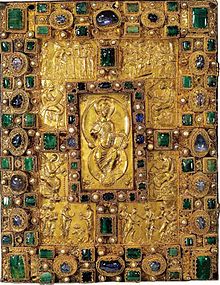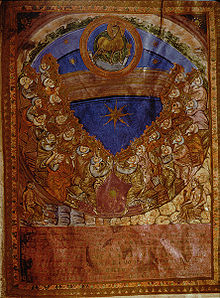- Codex Aureus of St. Emmeram
-
The Codex Aureus of St. Emmeram (Munich, Bayerische Staatsbibliothek, Clm 14000) is a 9th century illuminated Gospel Book. It is named after Emmeram of Regensburg and lavishly illuminated.
Contents
History
It was produced for the Holy Roman Emperor Charles II (the Bald) in 870 at his Carolingian Palace School. It is not known for certain where the Palace School was then based (after its previous base at St Martin's Abbey in Tours was destroyed in 853), but it had probably moved to the Basilica of St Denis outside Paris by the time of the Codex Aureus's production. Charles gave it to Arnulf of Carinthia. 11th century sources state it was produced in 893 and given to emperor Arnulf of Carinthia, who in turn donated it to St. Emmeram Abbey, then under abbot Tuto. On secularisation in 1811 it was given to the Bayerische Staatsbibliothek in Munich (catalogue reference Clm 14000).
In a decision dated 5 November 1930 at the I. Zivilsenat des Reichsgericht on copyright law, the picture of Charles enthroned in the Codex and a photographic copy of it in a textbook was used as an example,[1] stating "The connection between the written work and a picture in it, the presentation and teaching purpose being to support the text". The admissibility of the removal was denied because it does not adequately serve to illustrate the content. Today, the ruling doctrine of the true premise of the decision that the basic reproduction photography was protected, but no longer.
Content
It was written out by the monks Liuthard and Beringer. Seven full-page miniatures show the four evangelists, Charles the Bald enthroned, the Adoration of the Lamb and a Christ in Majesty. It also includes twelve canon tables, ten illuminated initials and incipits. The text is written in golden uncial letters, with each page framed. It measures 420 mm by 330 mm and has 126 vellum folios.
Its cover is goldplated and decorated with precious gemstones. At the centre of the cover appears Christ in Majesty seated on the globe of the world and holding on his knee a book inscribed with the words
“ I am the way, and the truth, and the life. No man cometh to the Father, but by me.[2] ” The inclusion of this inscription again identifies the Gospel Book with Christ. The verse makes equal sense if we read the speaker as Christ or as the Gospel Book.
References
- ^ RGZ 130, 196: commons:File:De RGZ 130 1.jpg
- ^ John 14:6
Further reading
- Walther, Ingo F. and Norbert Wolf. Codices Illustres: The world's most famous illuminated manuscripts, 400 to 1600. Köln, Taschen, 2005.
Categories:- Gospel Books
- 9th-century biblical manuscripts
Wikimedia Foundation. 2010.


